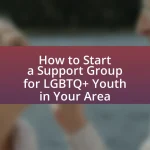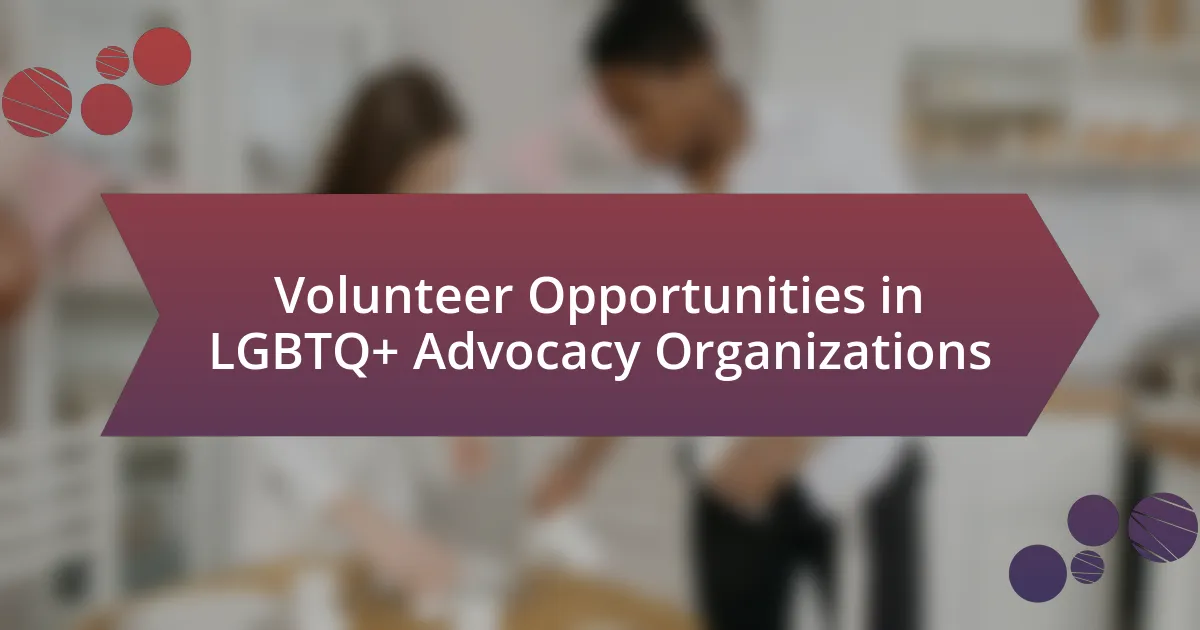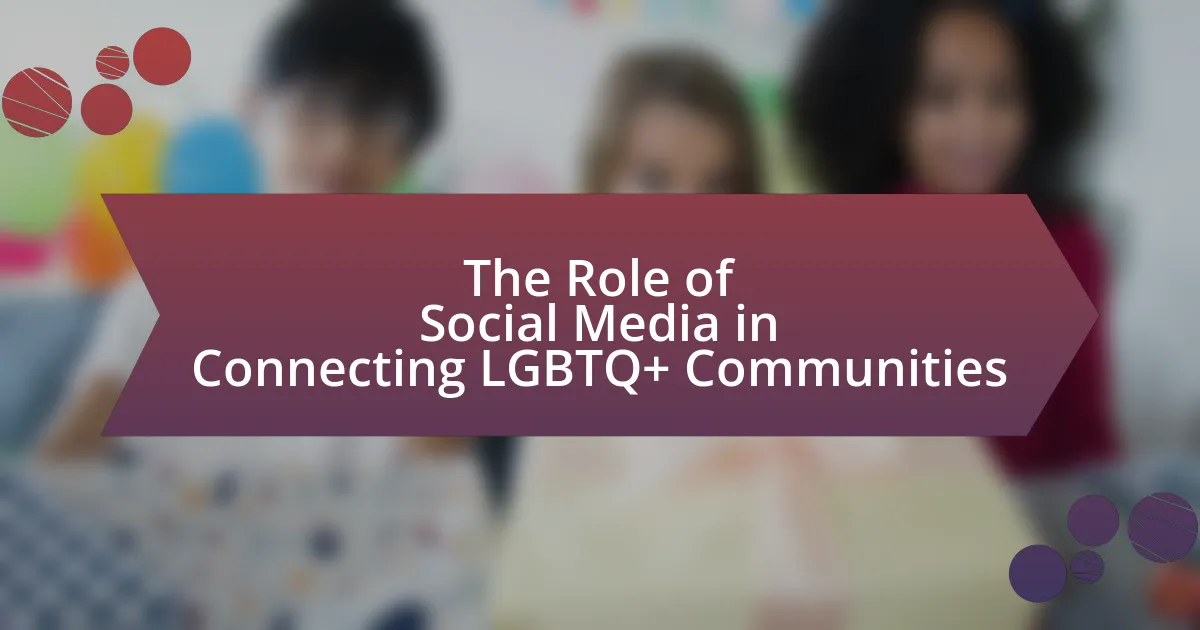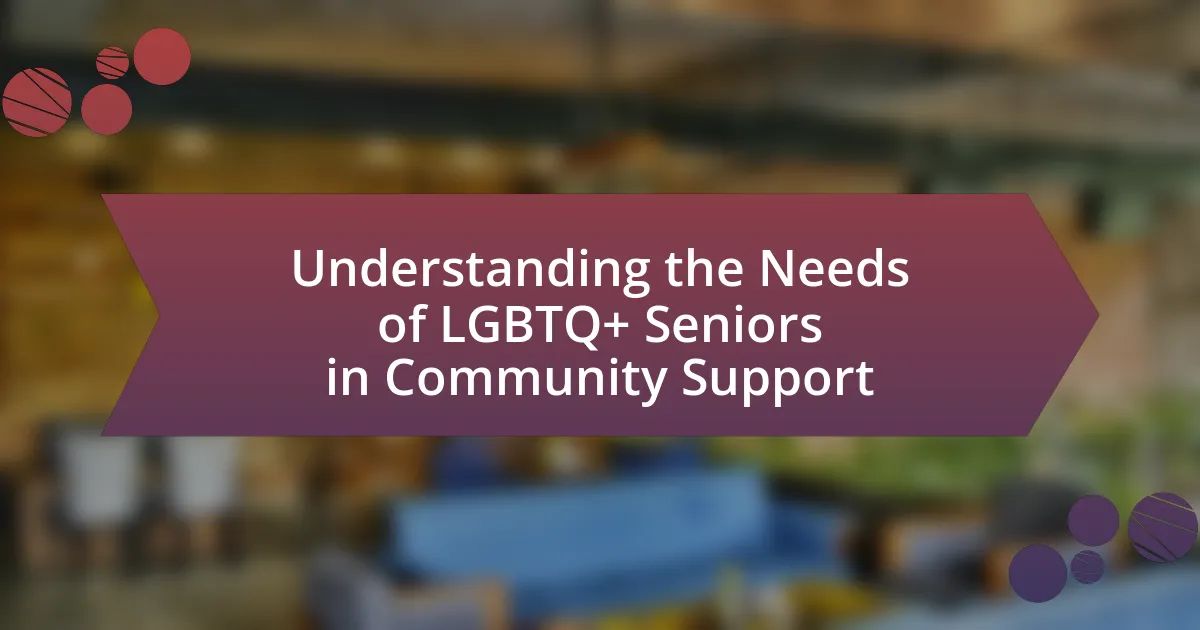The article focuses on the significance of intersectionality in supporting the LGBTQ+ community, emphasizing how overlapping social identities such as race, gender, sexual orientation, and socioeconomic status create unique experiences of discrimination and disadvantage. It discusses the necessity for inclusive support systems that address these complexities, highlighting the varying challenges faced by individuals within the community, particularly those who belong to multiple marginalized groups. Key components include the impact of systemic oppression, the importance of tailored advocacy, and the consequences of neglecting intersectionality in support services. The article also outlines practical steps for individuals and organizations to enhance intersectional support, ultimately aiming to foster equity and justice within the LGBTQ+ community.

What is Intersectionality in the Context of LGBTQ+ Community Support?
Intersectionality in the context of LGBTQ+ community support refers to the interconnected nature of social categorizations such as race, gender, sexual orientation, and class, which create overlapping systems of discrimination or disadvantage. This concept highlights that individuals within the LGBTQ+ community experience varying levels of oppression based on their unique identities and circumstances. For example, a Black transgender woman may face different challenges compared to a white gay man, as her experiences are shaped by both her race and gender identity. Research by Crenshaw (1989) introduced the term and emphasized the need for inclusive support systems that address these complexities, demonstrating that effective LGBTQ+ advocacy must consider the diverse experiences of all community members to foster equity and justice.
How does Intersectionality Influence the Experiences of LGBTQ+ Individuals?
Intersectionality significantly influences the experiences of LGBTQ+ individuals by highlighting how overlapping social identities, such as race, gender, and socioeconomic status, create unique challenges and discrimination. For instance, LGBTQ+ individuals who are also people of color often face compounded biases that differ from those experienced by white LGBTQ+ individuals, leading to increased vulnerability to violence and discrimination. Research from the Human Rights Campaign indicates that LGBTQ+ people of color report higher rates of discrimination and violence compared to their white counterparts, illustrating the critical need for intersectional approaches in advocacy and support services. This understanding of intersectionality is essential for developing effective community support that addresses the diverse needs of LGBTQ+ individuals.
What are the key components of Intersectionality within the LGBTQ+ community?
The key components of intersectionality within the LGBTQ+ community include the recognition of overlapping social identities, the impact of systemic oppression, and the importance of inclusive advocacy. Intersectionality acknowledges that individuals may experience multiple forms of discrimination based on their sexual orientation, gender identity, race, socioeconomic status, and other factors. For instance, Black LGBTQ+ individuals often face unique challenges that differ from those experienced by white LGBTQ+ individuals, highlighting the necessity for tailored support and resources. Research by Kimberlé Crenshaw, who coined the term “intersectionality,” emphasizes that understanding these complexities is crucial for effective advocacy and policy-making within the LGBTQ+ community.
How do different identities intersect to shape unique experiences?
Different identities intersect to shape unique experiences by creating a complex interplay of social, cultural, and personal factors that influence an individual’s perspective and challenges. For instance, a person who identifies as both LGBTQ+ and a person of color may face discrimination that is distinct from that experienced by a white LGBTQ+ individual, as highlighted in the research by Crenshaw (1989) on intersectionality, which emphasizes how overlapping identities can lead to compounded forms of marginalization. This intersectional lens reveals that experiences of oppression and privilege are not uniform; rather, they vary significantly based on the combination of identities such as race, gender, sexual orientation, and socioeconomic status.
Why is Intersectionality Important for Effective Community Support?
Intersectionality is important for effective community support because it recognizes the diverse and overlapping identities individuals hold, which influence their experiences and needs. By understanding how factors such as race, gender, sexual orientation, and socioeconomic status intersect, community support initiatives can be tailored to address the unique challenges faced by marginalized groups within the LGBTQ+ community. Research by Crenshaw (1989) highlights that failing to consider these intersecting identities can lead to inadequate support and reinforce systemic inequalities. Therefore, incorporating an intersectional approach ensures that community support is inclusive, equitable, and responsive to the complexities of individuals’ lived experiences.
What are the potential consequences of ignoring Intersectionality in support systems?
Ignoring intersectionality in support systems can lead to inadequate and ineffective assistance for marginalized individuals. When support systems fail to consider the overlapping identities of race, gender, sexual orientation, and socioeconomic status, they risk perpetuating existing inequalities and excluding those who face multiple layers of discrimination. For instance, research by Crenshaw (1989) highlights that Black women experience unique challenges that are not addressed by frameworks focusing solely on race or gender. Consequently, support systems that overlook these complexities may result in a lack of tailored resources, increased mental health issues, and a sense of alienation among individuals who do not fit into a singular narrative. This neglect can ultimately hinder the overall effectiveness of support initiatives within the LGBTQ+ community, as they may not resonate with or meet the needs of all individuals involved.
How can Intersectionality enhance the inclusivity of LGBTQ+ support services?
Intersectionality can enhance the inclusivity of LGBTQ+ support services by recognizing and addressing the diverse identities and experiences within the community. This approach allows support services to tailor their programs to meet the unique needs of individuals who may face multiple forms of discrimination, such as race, gender identity, socioeconomic status, and disability. For instance, research by Crenshaw (1989) highlights how marginalized groups experience overlapping social injustices, which necessitates a more nuanced understanding of their challenges. By implementing intersectional frameworks, LGBTQ+ support services can create more effective outreach strategies, develop culturally competent resources, and foster environments that validate the experiences of all community members, ultimately leading to improved mental health outcomes and greater overall satisfaction with the services provided.

What Challenges Does the LGBTQ+ Community Face Without Intersectional Support?
The LGBTQ+ community faces significant challenges without intersectional support, including increased discrimination, lack of access to resources, and heightened vulnerability to violence. Discrimination often manifests in healthcare, employment, and housing, where individuals from marginalized backgrounds, such as people of color or those with disabilities, experience compounded barriers. For instance, a 2017 study by the Williams Institute found that LGBTQ+ people of color reported higher rates of discrimination compared to their white counterparts, indicating that intersectionality plays a crucial role in understanding these disparities. Additionally, without intersectional support, mental health issues may be exacerbated due to social isolation and stigma, as highlighted by the 2020 National LGBTQ+ Youth Report, which noted that LGBTQ+ youth of color are more likely to experience depression and suicidal thoughts. Overall, the absence of intersectional support leads to a lack of tailored advocacy and resources, further marginalizing already vulnerable groups within the LGBTQ+ community.
How do systemic inequalities impact LGBTQ+ individuals from diverse backgrounds?
Systemic inequalities significantly impact LGBTQ+ individuals from diverse backgrounds by exacerbating their vulnerability to discrimination, economic hardship, and social exclusion. For instance, LGBTQ+ people of color often face compounded discrimination due to both their sexual orientation and racial identity, leading to higher rates of poverty and unemployment compared to their white counterparts. According to the 2021 U.S. Transgender Survey, 39% of Black transgender individuals reported being unemployed, a rate significantly higher than the national average. Additionally, systemic barriers in healthcare access result in LGBTQ+ individuals from marginalized backgrounds experiencing disparities in mental and physical health outcomes. The Williams Institute reports that LGBTQ+ individuals of color are more likely to experience mental health issues, such as depression and anxiety, due to the intersection of racism and homophobia. These systemic inequalities create a cycle of disadvantage that hinders the overall well-being and social integration of LGBTQ+ individuals from diverse backgrounds.
What role does socioeconomic status play in the experiences of LGBTQ+ individuals?
Socioeconomic status significantly influences the experiences of LGBTQ+ individuals by affecting their access to resources, support systems, and overall well-being. Higher socioeconomic status often correlates with better access to healthcare, legal protections, and supportive communities, which can mitigate the challenges faced due to discrimination and stigma. Conversely, LGBTQ+ individuals from lower socioeconomic backgrounds may experience increased vulnerability to mental health issues, homelessness, and economic instability, as evidenced by studies indicating that LGBTQ+ youth are disproportionately represented among homeless populations, with 40% identifying as LGBTQ+ (National Alliance to End Homelessness). This disparity highlights the critical need for intersectional approaches in community support that address both sexual orientation and socioeconomic factors to foster equitable outcomes for all LGBTQ+ individuals.
How do race and ethnicity intersect with sexual orientation and gender identity?
Race and ethnicity significantly intersect with sexual orientation and gender identity by influencing individuals’ experiences and challenges within the LGBTQ+ community. For instance, LGBTQ+ people of color often face compounded discrimination due to both their racial or ethnic identity and their sexual orientation or gender identity, leading to unique social, economic, and health disparities. Research from the 2015 U.S. Transgender Survey indicates that transgender people of color experience higher rates of violence and discrimination compared to their white counterparts, highlighting the critical need for intersectional approaches in advocacy and support services. This intersectionality underscores the importance of recognizing how multiple identities shape individual experiences, necessitating tailored support that addresses the specific needs of diverse community members.
What are the barriers to implementing Intersectional Approaches in Support Services?
Barriers to implementing intersectional approaches in support services include a lack of understanding of intersectionality among service providers, insufficient training, and systemic inequalities within organizations. Many service providers may not fully grasp how overlapping identities, such as race, gender, and sexual orientation, affect individuals’ experiences, leading to inadequate support. Research indicates that only 30% of social service organizations offer training on intersectionality, which limits staff’s ability to address diverse needs effectively. Additionally, funding constraints often prioritize singular identity-focused programs over comprehensive, intersectional initiatives, further hindering the implementation of these approaches.
What misconceptions exist about Intersectionality in the LGBTQ+ community?
A common misconception about intersectionality in the LGBTQ+ community is that it solely pertains to sexual orientation and gender identity, neglecting other social categories such as race, class, and disability. This misunderstanding limits the recognition of how multiple identities intersect to create unique experiences of discrimination and privilege. For instance, studies show that LGBTQ+ individuals of color often face compounded discrimination that is not adequately addressed when intersectionality is viewed narrowly. According to the 2015 U.S. Transgender Survey, 47% of Black transgender individuals reported being sexually assaulted in their lifetime, highlighting the critical need to consider race alongside gender identity in discussions of intersectionality.
How can organizations overcome resistance to adopting Intersectional frameworks?
Organizations can overcome resistance to adopting intersectional frameworks by providing comprehensive training and education on the importance of intersectionality in addressing diverse community needs. This approach fosters understanding and empathy among staff, highlighting how intersectional frameworks can enhance support for marginalized groups, particularly within the LGBTQ+ community. Research indicates that organizations implementing such training see increased engagement and commitment to inclusive practices, as evidenced by a study from the Human Rights Campaign, which found that 70% of organizations that prioritized intersectional training reported improved workplace culture and better service delivery to diverse populations.

How Can Intersectionality Be Integrated into LGBTQ+ Community Support Initiatives?
Intersectionality can be integrated into LGBTQ+ community support initiatives by ensuring that programs address the diverse identities and experiences within the community, including race, gender, socioeconomic status, and disability. This integration can be achieved through the development of tailored resources and services that reflect the unique challenges faced by individuals at the intersections of these identities. For example, research from the Human Rights Campaign highlights that LGBTQ+ people of color often experience higher rates of discrimination and violence, necessitating targeted support that acknowledges these disparities. Additionally, involving intersectional voices in leadership roles within organizations can enhance the relevance and effectiveness of initiatives, as seen in successful programs that prioritize inclusivity and representation.
What best practices can organizations adopt to promote Intersectional support?
Organizations can promote intersectional support by implementing comprehensive training programs that educate staff on the diverse identities within the LGBTQ+ community. These programs should focus on understanding how various social categories such as race, gender, and socioeconomic status intersect and affect individuals’ experiences. Research indicates that organizations that prioritize intersectional training see improved inclusivity and employee satisfaction, as highlighted in the report “Intersectionality in the Workplace” by the American Psychological Association, which found that inclusive practices lead to better mental health outcomes for marginalized groups. Additionally, organizations should establish support networks that specifically address the unique challenges faced by individuals at these intersections, ensuring that resources are accessible and tailored to meet diverse needs.
How can training and education enhance understanding of Intersectionality?
Training and education can enhance understanding of intersectionality by providing individuals with the knowledge and tools to recognize and analyze the interconnected nature of social identities and systems of oppression. This understanding is crucial for effectively supporting marginalized communities, such as those within the LGBTQ+ spectrum. Research indicates that comprehensive training programs, such as those developed by the Human Rights Campaign, improve awareness of how factors like race, gender, and sexual orientation intersect, leading to more informed advocacy and allyship. Furthermore, educational initiatives that incorporate real-life case studies and experiential learning foster empathy and critical thinking, enabling participants to better navigate the complexities of intersectionality in their interactions and support efforts.
What role do community partnerships play in fostering Intersectional support?
Community partnerships play a crucial role in fostering intersectional support by creating collaborative networks that address the diverse needs of marginalized groups within the LGBTQ+ community. These partnerships enable organizations to pool resources, share knowledge, and amplify voices that may otherwise be overlooked, ensuring that support services are inclusive and culturally competent. For instance, studies have shown that collaborative efforts between LGBTQ+ organizations and other community groups lead to more effective outreach and engagement strategies, ultimately improving access to healthcare, legal assistance, and mental health resources for individuals facing multiple forms of discrimination.
What are some successful examples of Intersectional Support in Action?
Successful examples of intersectional support in action include the Black LGBTQ+ Lives Matter movement, which addresses the unique challenges faced by Black LGBTQ+ individuals, and the Transgender Law Center’s work in advocating for policies that protect the rights of transgender people of color. These initiatives highlight the importance of recognizing and addressing the overlapping identities and experiences within the LGBTQ+ community. For instance, the Black LGBTQ+ Lives Matter movement has successfully mobilized resources and awareness around issues such as police violence and healthcare disparities, demonstrating the effectiveness of intersectional advocacy. Similarly, the Transgender Law Center has influenced legislation that specifically protects marginalized groups, showcasing the impact of intersectional approaches in creating inclusive support systems.
How have specific organizations effectively implemented Intersectional approaches?
Organizations such as the Human Rights Campaign (HRC) and the National LGBTQ Task Force have effectively implemented intersectional approaches by integrating diverse identities into their advocacy and support frameworks. The HRC, for instance, has developed initiatives that specifically address the unique challenges faced by LGBTQ+ individuals of color, recognizing that race, gender, and sexual orientation intersect to create distinct experiences of discrimination. The National LGBTQ Task Force has similarly focused on policy advocacy that considers the intersections of socioeconomic status, disability, and immigration status, ensuring that their programs are inclusive and representative of the entire LGBTQ+ community. These organizations utilize data-driven strategies, such as the “LGBTQ+ Youth Report” by the HRC, which highlights the compounded effects of discrimination faced by marginalized groups within the LGBTQ+ community, thereby reinforcing the necessity of intersectional approaches in their work.
What lessons can be learned from successful Intersectional initiatives?
Successful intersectional initiatives demonstrate the importance of inclusivity and collaboration across diverse identities. These initiatives highlight that addressing the unique challenges faced by individuals at the intersection of multiple marginalized identities leads to more effective support systems. For instance, research by Crenshaw (1989) emphasizes that intersectionality reveals how overlapping social identities can compound discrimination, necessitating tailored approaches to advocacy and resource allocation. Furthermore, successful initiatives often involve community engagement, ensuring that the voices of those affected are central to decision-making processes, which enhances trust and efficacy in support services.
What Practical Steps Can Individuals Take to Support Intersectionality in the LGBTQ+ Community?
Individuals can support intersectionality in the LGBTQ+ community by actively educating themselves about the diverse identities and experiences within the community. This includes understanding how factors such as race, gender, socioeconomic status, and ability intersect with sexual orientation and gender identity. Engaging in workshops or reading literature from LGBTQ+ authors can enhance this understanding.
Additionally, individuals can amplify marginalized voices by sharing their stories and advocating for policies that address the unique challenges faced by intersectional identities. For instance, supporting organizations that focus on the needs of LGBTQ+ people of color or those with disabilities can create a more inclusive environment.
Moreover, participating in local events that celebrate diversity within the LGBTQ+ community, such as Pride events that highlight intersectionality, fosters solidarity and awareness. Research shows that inclusive practices lead to better mental health outcomes for marginalized groups, reinforcing the importance of intersectional support.
How can allies contribute to Intersectional advocacy and support?
Allies can contribute to intersectional advocacy and support by actively listening to and amplifying the voices of marginalized groups within the LGBTQ+ community. This involves recognizing the diverse identities and experiences that intersect with sexual orientation and gender identity, such as race, class, and disability. For example, research from the Human Rights Campaign indicates that LGBTQ+ individuals of color face unique challenges, and allies can support initiatives that address these specific issues, such as advocating for policies that promote equity and inclusion. By participating in educational workshops and community events, allies can also enhance their understanding of intersectionality, thereby fostering a more inclusive environment that respects and uplifts all identities within the LGBTQ+ spectrum.
What resources are available for individuals seeking to educate themselves on Intersectionality?
Individuals seeking to educate themselves on intersectionality can access a variety of resources, including academic texts, online courses, and community organizations. Notable academic texts include “Intersectionality” by Kimberlé Crenshaw, which lays the foundational concepts of the theory, and “Sister Outsider” by Audre Lorde, which explores the intersections of race, gender, and sexuality. Online platforms like Coursera and edX offer courses on intersectionality, often featuring lectures from experts in the field. Additionally, organizations such as the American Psychological Association provide resources and publications that discuss intersectionality in relation to mental health and social justice. These resources collectively enhance understanding of how various social identities intersect and impact individuals’ experiences, particularly within the LGBTQ+ community.





